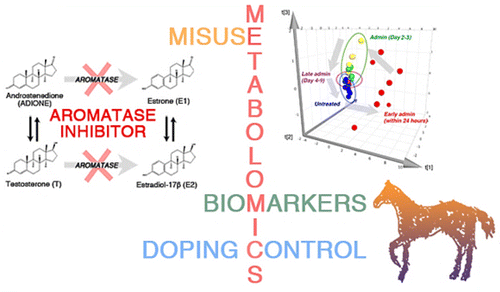Doping in the horseracing industry has spurred regulations banning performance-enhancing drugs, as well as calls for an anti-doping agency in the U.S. But as in human sports, testing for certain kinds of prohibited substances has been a challenge. Now scientists report in ACS' journal Analytical Chemistry a new detection method that could help anti-doping enforcers determine whether a horse has received certain substances.
To give their animals an edge on the track, some horse trainers and veterinarians might administer a single substance, a cocktail of hormones, hormone-mimicking compounds or other drugs. Most are prohibited in the racing world, but catching violators can in some cases be difficult with conventional methods. Existing techniques directly test for the original compounds administered to an animal or their unique metabolites or byproducts. But some of these substances can get processed and eliminated by the animal quickly, making the window for detection very short. George Ho Man Chan, Terence See Ming Wan and colleagues are currently investigating unconventional ways to increase the chances of catching cheaters.
The researchers have identified seven biomarkers in urine that potentially indicate whether a horse has been given aromatase inhibitors, a class of compounds also used by bodybuilders to help regulate hormones and get an edge on the competition. Testing for the changes in these naturally-occurring biomarkers in horse urine could reveal the administration of the substances for about 95 to 195 hours after injection. That's 2 to 2.5 times longer than conventional screening methods. Being able to find evidence for the administration of these drugs for two or more days longer than before could increase the chances that rule-violators will be caught. With further validation studies, this method could be developed into a useful screening tool for detecting the use of aromatase inhibitors in horses.
More information: George Ho Man Chan et al. Targeted Metabolomics Approach To Detect the Misuse of Steroidal Aromatase Inhibitors in Equine Sports by Biomarker Profiling, Analytical Chemistry (2016). DOI: 10.1021/acs.analchem.5b03165
Abstract
The use of anabolic androgenic steroids (AAS) is prohibited in both human and equine sports. The conventional approach in doping control testing for AAS (as well as other prohibited substances) is accomplished by the direct detection of target AAS or their characteristic metabolites in biological samples using hyphenated techniques such as gas chromatography or liquid chromatography coupled with mass spectrometry. Such an approach, however, falls short when dealing with unknown designer steroids where reference materials and their pharmacokinetics are not available. In addition, AASs with fast elimination times render the direct detection approach ineffective as the detection window is short. A targeted metabolomics approach is a plausible alternative to the conventional direct detection approach for controlling the misuse of AAS in sports. Because the administration of AAS of the same class may trigger similar physiological responses or effects in the body, it may be possible to detect such administrations by monitoring changes in the endogenous steroidal expression profile. This study attempts to evaluate the viability of using the targeted metabolomics approach to detect the administration of steroidal aromatase inhibitors, namely androst-4-ene-3,6,17-trione (6-OXO) and androsta-1,4,6-triene-3,17-dione (ATD), in horses. Total (free and conjugated) urinary concentrations of 31 endogenous steroids were determined by gas chromatography-tandem mass spectrometry for a group of 2 resting and 2 in-training thoroughbred geldings treated with either 6-OXO or ATD. Similar data were also obtained from a control (untreated) group of in-training thoroughbred geldings (n = 28). Statistical processing and chemometric procedures using principle component analysis and orthogonal projection to latent structures-discriminant analysis (OPLS-DA) have highlighted 7 potential biomarkers that could be used to differentiate urine samples obtained from the control and the treated groups. On the basis of this targeted metabolomic approach, the administration of 6-OXO and ATD could be detected for much longer relative to that of the conventional direct detection approach.
Journal information: Analytical Chemistry
Provided by American Chemical Society





















